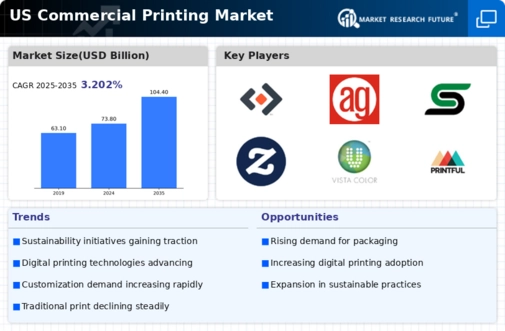The US Commercial Printing Market is characterized by a dynamic competitive landscape where innovation and adaptability are essential for success. Companies in this sector are constantly evolving to meet the changing demands of technology and consumer needs, ranging from digital to traditional printing solutions. The market features established players who have maintained significant market shares through strategic investments in advanced printing technologies and enhancements in service offerings. The versatility in applications, including promotional materials, packaging, and publishing, allows various companies to carve out niches and establish brand loyalty.
In this environment, understanding competitive insights such as market trends, technological advancements, and customer preferences is crucial for companies aiming to solidify or enhance their positions.
Quad Graphics is a formidable entity within the US Commercial Printing Market, notable for its extensive array of services that encompass not only traditional printing techniques but also a strong focus on digital solutions. The company has developed significant strengths in its capabilities to produce high-quality print materials at scale, leveraging advanced technologies and automation to streamline operations and reduce turnaround times. Quad Graphics stands out due to its commitment to sustainability, investing in eco-friendly processes and materials that resonate with increasingly environmentally conscious consumers.
Additionally, its strong network and established relationships within various industries enable the company to maintain a competitive edge, ensuring it can meet the diverse needs of its clientele effectively.PBM Graphics holds a solid position within the US Commercial Printing Market, offering a diverse portfolio of printing services that include commercial printing, digital printing, and specialized finishing solutions.
The company's strengths lie in its ability to deliver high-quality, custom printing services tailored to meet specific client requirements, enhancing customer satisfaction and fostering long-term relationships. PBM Graphics has successfully navigated the marketplace through strategic mergers and acquisitions to expand its service offerings and market presence, ensuring robust growth and sustainability. The company's dedication to innovative solutions and operational efficiency has allowed it to adapt to market dynamics swiftly, making it a reliable partner for customers seeking comprehensive printing services in the US region.
Its focus on exceptional customer service and rapid turnaround times further solidifies its reputation as a key player in the competitive commercial printing landscape.



















Leave a Comment